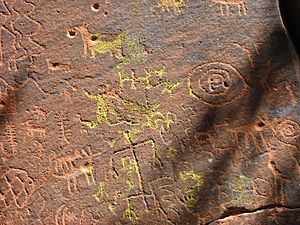Crane Petroglyph Heritage Site facts for kids
The Crane Petroglyph Heritage Site is a really cool place in central Arizona. It's the biggest petroglyph site in the Verde Valley. Petroglyphs are ancient drawings carved into rocks.
This site has 1,032 petroglyphs spread across 13 large rock panels. It's one of the best-preserved sites of its kind. The US Forest Service protects this special place.
They keep it open for everyone to visit. Volunteer rangers are often there to give tours. They help explain the history and meaning of the rock art.
You can find a visitor center at the site. It has restrooms and a small bookstore. The fenced petroglyph area is an easy half-mile walk from the parking lot.
Contents
History of the Crane Petroglyphs
Who Made the Petroglyphs?
The amazing petroglyphs at this site were made by the Southern Sinagua people. They lived in this area a long time ago. These carvings were created between about 1150 and 1400 AD.
How the Site Was Protected
Early American settlers knew about this site. It became part of the historic V Bar V ranch in 1927. Some old ranch buildings are still near the visitor center today.
The US Forest Service bought the site in 1994. This helped to protect the ancient rock art. Now, people can visit and learn about this important part of history.
Understanding Beaver Creek Rock Art Style
What is Rock Art Style?
Rock art is like a special language from the past. Archaeologists study it to learn about ancient cultures. A "rock art style" helps them identify different groups of people. It also shows when they lived.
Features of the Beaver Creek Style
The Beaver Creek rock art style is found in the Beaver Creek area. The Crane Petroglyph site is very important for understanding this style. This style is unique to the Southern Sinagua culture. It was used between 1150 and 1400 AD.
About 20% of the petroglyphs here are zoomorphs. These are drawings of animals. You can see snakes, turtles, coyotes, deer, and antelope. Other common types are anthropomorphs, which look like humans. There are also many geometric shapes. These include spirals and grids.
Why Crane Petroglyph Site is Special
The Crane Petroglyph Heritage Site is unusual. Almost all the carvings here are in the Beaver Creek style. They are also well-spaced out. This means new designs were rarely drawn over older ones. This makes it easier for experts to study them. It gives us clear information about this ancient art style.
See also
- Wet Beaver Wilderness – a wilderness area nearby




